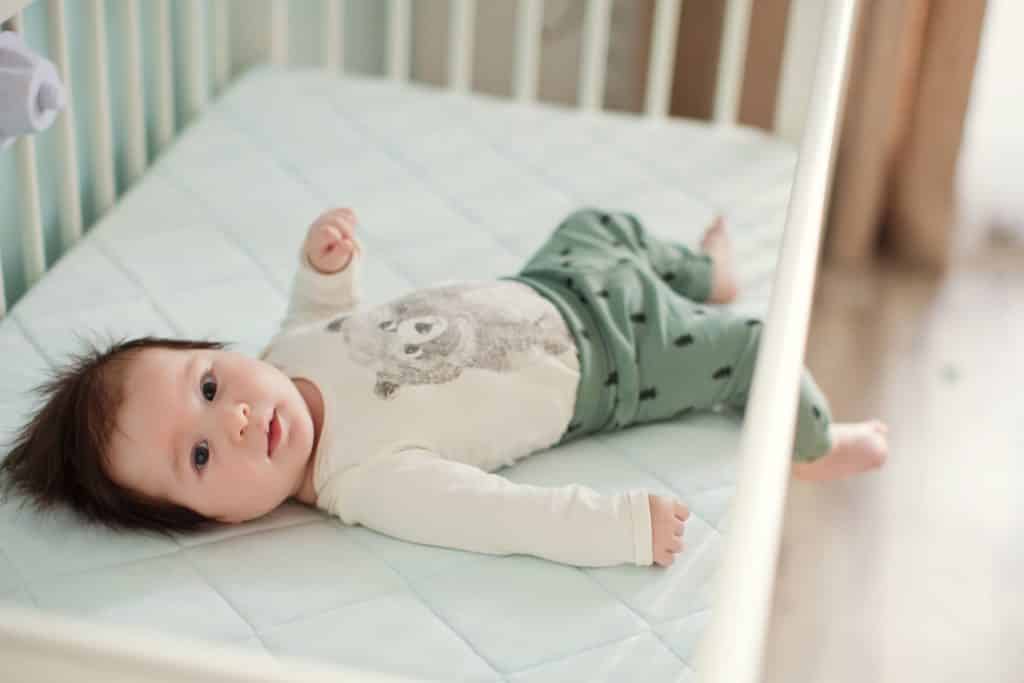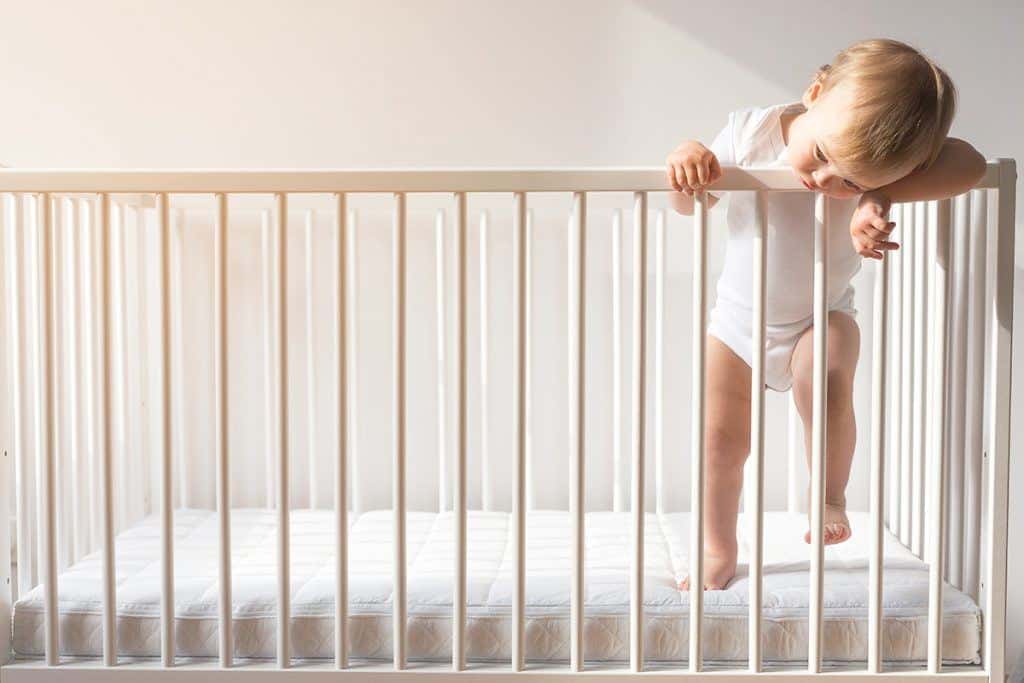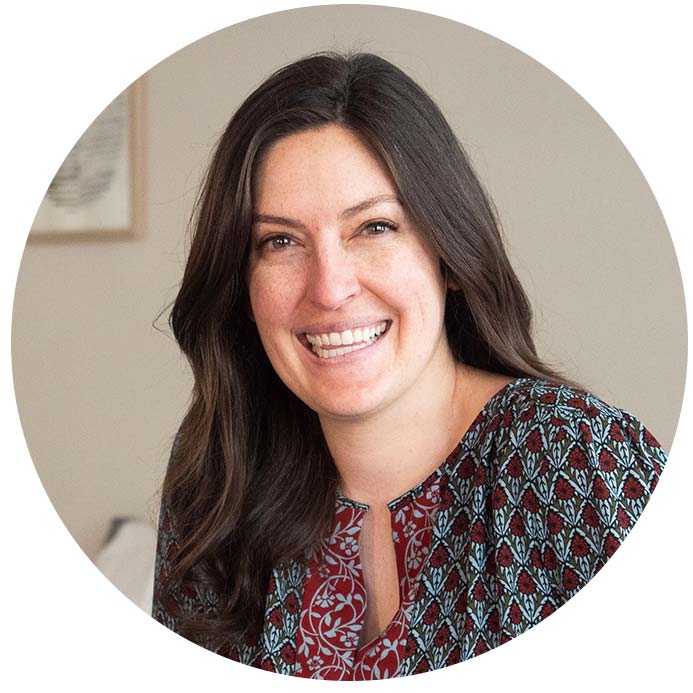When it comes to picking a crib mattress for your child, safety and comfort are top priorities. Today there are multiple types of crib mattresses available, each coming in a range of thicknesses, with varying materials and price ranges. There are also some specific safety standards and certifications you will want to look for with your crib mattress – it can be a different shopping experience than picking out a bed for yourself.
With so many bits of information to keep track of, it can be overwhelming looking for a crib mattress for your baby. While we encourage you to speak with a pediatrician about the best crib mattress for your child, we’ve put the important information together – from the basics to the important details – to make sure you find the best mattress for your sweet babe.
 aprilante/Shutterstock
aprilante/Shutterstock
Types of Crib Mattresses
Some aspects of shopping for your baby or toddler’s crib will be similar to shopping for your personal bed. Crib mattresses tend to come in two main categories – foam and innerspring. We’ve expanded on each one below.
Foam: These crib mattresses tend to be popular because they are more lightweight than innerspring and will most likely be the less expensive option. They tend to come in different thicknesses but typically range from 3” to 6”.
To help prevent Sudden Infant Death Syndrome (SIDS) and suffocation, it is important to pick a foam crib mattress that is designed for infants. It should be firmer as opposed to softer.
The American Academy of Pediatrics (AAP) recommends avoiding memory foam crib mattresses or mattress toppers. The foam mattress needs to be firm and maintain its shape. Using a mattress topper or mattress made of memory foam allow for the creation of an indentation or pocket by the baby’s head, which could increase the baby’s chances of suffocation.
Innerspring: These mattresses feature steel coils covered by a layer of foam, padding, and fabric. Better quality materials will be heavier and more durable. The BabyCenter says a lower gauge means a thicker wire, which is stronger and therefore firmer.
“The amount of the steel in an innerspring is how you evaluate the spring unit in an innerspring mattress, not the number of the coils,” says Dennis Schuetz of Colgate Juvenile Products in a Consumer Reports article. The report says that the thickness of crib-mattress coils ranges from 19 to 12.5 gauge, with a lower number equating to a thicker steel. “Look for a moderate to high coil count,” Schuetz said. “About 135 to 150 is a good midrange.” You should also consider a steel gauge of 15.5 or below.
RELATED: Best Mattress for Toddlers
Considering Organic
Today, there are plenty of organic mattresses available in stores and online. These can still be primarily foam or innerspring, they are just made with organic and all-natural materials. Some of these materials include:
- Organic cotton
- Wool
- Coconut fibers
- Food-grade polymers
- Plant-based foam
- Natural latex
Because of the quality of the organic and natural materials, organic crib mattresses tend to be more expensive and are not available on everyone’s budget.
Advocates of organic and natural crib mattresses point to the potential toxicity of some materials used in standard crib mattresses. According to an article from the BabyCenter, “they contend that chemicals and industrial compounds used in standard mattresses – flame retardants are known as PBDE (polybrominated diphenyl ethers), vinyl, and polyurethane foam, for instance – emit toxic gases, and that the substances used to make mattresses could harm babies. Others say materials like latex can produce an allergic reaction in infants.”
Look closely at mattresses that are labeled “organic”. Oeko-Tex Standard 100 certification is a worldwide certification that will confirm that certain flame retardants and some heavy metals are not used in the mattress.
RELATED: Naturepedic Ultra-Breathable Organic Crib Mattress Review
What To Look For
- Buy New. Avoid using a second-hand crib mattress if possible. There are a couple of reasons for this. Old or worn mattresses – especially those with foam or padding – can be a breeding ground for bacteria that may impact your baby’s health. Older mattresses will not be as firm, either, making it an unsafe sleep environment for new babies.
- Sizing. The legal size for a crib mattress – which is set by the CSPC – is at least 27.25″ x 51.25″ inches, with a thickness not exceeding 6 inches. You want to make sure your mattress fits your crib perfectly and snugly. Per CPSC guidelines, make sure there are no gaps larger than two fingers between the sides of the crib and the mattress. A more precise measurement is no more than a 1″ gap. Gaps create spaces for a newborn’s head to get trapped and potentially suffocate.
- Weight. Foam mattress weigh around seven to eight pounds but can weigh as much as 20 pounds as polyurethane foam can be heavier. Innerspring mattresses with coils will be heavier, closer to 15 to 30 pounds.
- Covers. Consider a breathable waterproof or eco-friendly (waterproof) cotton cover for the mattress, to protect it from inevitable accidents and spills. Removable covers make it easy to take off and wash. Make sure it fits snugly and goes underneath the crib sheet, which will stop it from becoming a suffocation hazard.
- Venting. You want to purchase a mattress and mattress cover that will promote airflow and allow your baby to breathe easily, especially when they roll over onto their stomachs. Look for specially constructed vents in the side of the mattress to keep air flowing.
- 2-Stage crib mattresses. You may see some mattress marketed as “2-Stage” crib mattress. This means that the mattress is dual-sided can be flipped over during different stages of your child’s development. One side of the mattress is firmer for younger infants and the other is softer for toddlers. Always consult with your pediatrician before deciding which side is appropriate for your child. There should be a tag at the end of the mattress to tell you which side is which.
Crib Mattress Standards & Certifications
Safety is a huge factor when picking out a crib mattress. If you are purchasing your crib mattress in the US, it must meet safety standards set by the US Consumer Product Safety Commission and the American Society for Testing and Materials.
According to the BabyCenter, the Juvenile Products Manufacturer Association (JPMA) does not test or certify crib mattresses.
There are some additional well-known certifications to take a look at if you’re looking for a crib mattress that is made with organic or natural materials.
- Oeko-Tex Standard 100 certification: This certification confirms that testing, including the processing done, was done and the product has been screened for harmful substances. Keep in mind that only some parts of a crib mattress may be Oeko-Tex certified, so read the fine print.
- Global Organic Textile Standard (GOTS): GOTS is a standard for textiles made from organic fibers. According to the GOTS website, the standard “defines high-level environmental criteria along the entire organic textiles supply chain and requires compliance with social criteria as well.” Textiles can only be GOTS certified if they contain a minimum of 70% organic fibers.
- GREENGUARD Certification: The GREENGUARD Certification Program℠ is a third-party testing program for emissions from consumer products and materials. GREENGUARD tests for criteria based on industry and governmental standards. Please know, there is no standard for “natural” mattresses, so you should look at the specific certification for each mattress you are interested in.
 Mallmo/Shutterstock
Mallmo/Shutterstock
Prices
You can find infant and toddler crib mattresses in a wide range of prices. Some are available for around $40 and others – most likely made with organic and durable materials – can go up to $400 or more.
The Bottom Line
No matter which crib mattress you choose for your baby, it is essential that you follow the American Academy of Pediatrics (AAP) guidelines for safe sleep. This includes putting your baby to sleep on his/her back and removing all toys, blankets, pillows or other things that could potentially suffocate your baby during the night.
Similarly, avoid using crib bumpers. Both the AAP and SIDS prevention groups warn against crib bumpers – including breathable mesh liners. According to experts, there is no evidence to show these prevent injuries and even mesh liners can still reduce airflow in your baby’s crib, which is a contributing factor for SIDS.
Related: How to Transition Your Child from Crib to Bed
Featured image: Dasha Petrenko/Shutterstock

